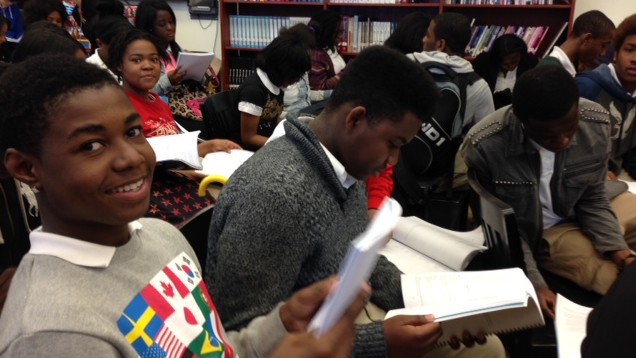What I like about the moon is that the moon that we see in Detroit is the same moon that is seen in Sudan, Paris, Itza, Sienna, Queens. It’s true that sometimes the moon might be blocked by clouds, by trees, by fog, by a forgetfulness to look up, but when we do lift our eyes to see it, we all know what it is. “Look, Daddy, the moon,” the little girl who is my daughter says on the subway back to Brooklyn as we move from beneath the city to rise up to the Smith-9th Street stop in Carroll Gardens. The awe and wonder in her voice sends all eyes turning outward and upward to the moon as it is held between the open hands of two sky-kissing buildings. Yes, the moon, it’s beautiful, it’s a thing to turn to, to see, to honor, to be stunned by its bigness, how white it is when it is full, the way it changes color and shape and maybe even has the power to alter our moods.
“But what,” I ask my students, “what if the moon was more than what we’ve been told it is?”
“I’ve never been there,” I say. “Have you? How do we know the moon is what we think it is? What if the moon were…what? What else might or could the moon be?”
Sometimes leading up to this question and this discussion, I will draw shapes on the board: a square, a triangle, a circle.
“What is this?” I ask.
A square, yes, a triangle, true, a circle, okay.
“But what else could this be?” I ask, and I point to the circle. “It’s a circle, true, but what else might this circle be a picture of?”
The students—3rd-graders, 6th-graders, high school and college students, I do this activity with students across the board—immediately begin to think of circle-shaped things like baseballs, oranges, a face, a wheel, a button, the bottom of a bucket, a plate we eat dinner on, a hula hoop, the top of a top hat.
You get the picture. Words, words, a constellation of words quickly takes shape across this blackboard sky.

That’s when I move our discussion and our imaginations away from the circle on the board and point up to the circle that is somewhere in somebody’s sky, even if right now we can’t see it—the moon, la luna—we know that it’s there.
What I love about bringing the moon into the classroom is that it’s a universal object. A little girl in Manhattan—Kansas or New York—or an old man in Kenya, a mother in Missoula, each of these people has equal access to a shared sky, a sky that has up in it a communal light—a light that is sometimes a circle cut in half, a light that is at other times a hammock hung between stars—a light, in short, that all eyes can see in new, never-before ways.
By seeing the moon as something more than what we think we know it to be, we can make use of a common image—a static image, a clichéd image—that may contain truths we didn’t realize we knew. This kind of seeing and saying speaks to the question: How do we know what we think until we see what we say?
And so I ask, “What else might the moon be?”
There’s a poem that I sometimes bring in to the classroom by the too-little known poet Frank Stanford, who died at the age of 29, too soon, too soon. But his poems live on, the way that the moon lives on, the way that it spins in its orbit around the Earth.
The poem, simply titled “The Moon,” begins, “I think the moon is a ship/ putting out without me/ Or a white horse/ that throws all riders/ It is a rooster/ molting dark feathers in the water/ …”
It—the moon—is also, according to Stanford: a beekeeper, a snake, a schoolgirl weeping, a stone.
“The moon,” I point out, through the eyes of this poem, “is a multitude of things. It could be anything, at least in the world of the poem.”
“Anything,” I often hear myself say to students, “is possible in a poem.”
“A poem, remember, is—” and here I break off into a litany of all the things we’ve already discovered a poem is.
Here are some words about what a poem is from some of their own poems:
—a poem is my body and the words are my clothes
—a poem is the wind rushing past the houses
—a poem is a cat that barks like a dog and no one judges it
—a poem is the stars looking at stars looking at stars looking at stars
And here are two of their moon poems, written by 3rd-graders, both in their entirety:
The Moon
by Princess LeakI think the moon is a
snowball filled with water.Maybe the moon is a spaceship
going to earth.The moon is like the letter
D in the name De’Ja.I know the moon is a house
with girls having a sleepover.
The Moon
by Joseph CarterI think the moon is a sunspot
blown off the sun, or maybeit’s a glowing piece of silver.
I think the moon is a saucerof milk. Or the moon is a lost
little boy who brings lightto the night so other people
don’t get lost like him.
I especially love this last metaphor—of the lost little boy—which is an example of what I like to call “an emotional image,” an image that is more than the sensory thing itself, an image that often seems to come unpredictably out of nowhere, and yet it makes the poem more than what it would be or say without it.
It gives the poem, in this case, its heft, its resonance, the thing that we carry out from the poem after we finish reading it.
The moon in this image, even though it may be lost, still offers hope, or “light,” to those who see it, who encounter it here in this poem, so that we feel a little less lost having seen it.
That’s how the moon works, its power, its gravitational pull. It’s how a poem works, too, I think. Both the moon and the poem make those of us who see them, who make room for them in our own little worlds, a little less alone.
Some other things, in the eyes and words of these children, that the moon might be: a thought in the universe, a donut with no hole, a stone frozen in air, a clock with no numbers or arms, a power socket in a dark wall, a dark penny in the sky.
Think about that—all of these things, these images, metaphors for the moon—the next time you step outside at night.
The Moon
by Frank StanfordI think it is a ship
putting out without me
A white horse
that throws all riders
And a swimmer who is naked
who believes she is asleep
It is a rooster
molting dark feathers in the water
Or a beekeeper who dreams
someone has found her out in the garden
A snake which sheds
its skin in the riverbed at night
And a schoolgirl weeping
under a black patch
I know it is only a stone
everybody keeps a blind date with
Peter Markus is the senior writer with InsideOut Literary Arts Project of Detroit, where he has worked as a writer in the public schools for the past 20 years. In those 20 years, he has also published six books of fiction, the most recent of which is The Fish and the Not Fish. He also edited, with InsideOut founder Terry Blackhawk, To Light a Fire: 20 Years with the InsideOut Literary Arts Project, published in 2015 by Wayne State University Press.



